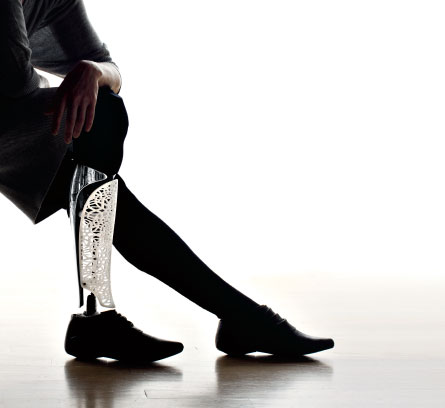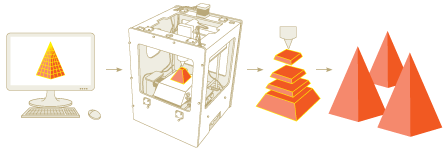- More than 2 years ago
Joshua Pearce takes unusual satisfaction in strolling through Walmart. The shelves laden with toys, household items, tools and clothing inspire in him a certain smugness, a pride in American entrepreneurship. But it’s not because Pearce admires the chain as an empire built by a self-made man. Pearce swells with pride at Walmart because the store is full of mass-manufactured objects that he could make himself.







“I take great pleasure — and my wife teases me about it — walking though Walmart and saying, ‘I could print that, I could print that, I could print that,’ ” Pearce says.
Pearce is at the forefront of what may be the next manufacturing revolution. Using a technique known as 3-D printing, regular people can now make goods typically produced in huge quantities in factories overseas. Need a mug? A tape dispenser? A chess piece? A pair of shoes? It’s as simple as pressing the print key.
3-D printing builds objects by piling up successive layers of material, hence its more technical moniker, “additive manufacturing.” You start by designing your product on a computer screen with drafting software. That design then goes through a program that slices it up, translating it into a stack of two-dimensional layers. The printer constructs the object by depositing the first layer of material — such as molten plastic that hardens — and then another and another, gradually creating the desired shape. As the printer head moves back and forth, your 3-D vision becomes reality.
The last few years have seen an explosion in the sale of personal 3-D printers. Like computers, the machines were once found only in well-funded academic, government and industrial settings. Available since the late 1980s, these machines cost tens of thousands of dollars and primarily printed prototypes. But now anyone can send a design to the 3-D printing equivalent of Kinko’s to have any number of copies made. And home printers, in most cases smaller than a washing machine, are available for around $400 to $4,000. In 2011 alone, annual sales of personal 3-D printers grew by almost 300 percent, to more than 23,000 units worldwide. People are printing jewelry, smartphone cases, headphones, lamps — even food.
Many herald 3-D printing as a game changer, a “disruptive” technology that will turn traditional manufacturing on its head. But the technology is also at the peak of hype.
“Everybody’s talking about it right now,” says Hod Lipson, an engineer and computer scientist at Cornell University. “It could be huge or it could just be a blip.”
Whether 3-D printing turns out to be a mere blip or a battering ram that renders present-day manufacturing unrecognizable remains to be seen. For now, there is no doubt that the technology is a powerful tool. It eliminates the time and expense of creating complicated, intricate objects. It can also remove the “mass” from mass manufacturing by making a limited run of a product affordable. Anyone can produce small batches, or even a batch of one. The technology democratizes innovation, says Lipson. If you can think it, you can probably print it.
Stuff abounds
Still, envisioning what exactly 3-D printers will deliver is difficult. In some respects it is like trying to imagine back in the 1960s the role computers would play in people’s lives today. If you had asked someone then what was so special about computers, you would probably hear about how fast they can do calculations. Their pervasive role today — not just in number-crunching but in banking, communication, entertainment and more — would have been hard for most to foresee.
One thing does seem certain: “I think initially,” says Lipson, “we’ll have a lot more junk.”
Junk proliferates on Thingiverse, a website created by 3-D printer manufacturer MakerBot where people upload and share their designs. There are specs for heart-shaped charms, models of the Eiffel Tower and a plastic octopus wearing a monocle and top hat. Another site devotes itself to downloadable designs that enable people to create the intricate, blocky structures found in the computer game Minecraft.
“There is a lot of stuff that has no value, no improvement for humanity,” says Pearce, a materials scientist and engineer at Michigan Technological University in Houghton. “There is a possible moral hazard that we will make a lot more junk.”
But among the clutter, there are also plenty of utilitarian items: shoehorns, tie hangers, pliers and boxes customized for carrying batteries, ammunition, pills and playing cards. Replacement parts abound, including flushing mechanisms for toilets, kitchen stove knobs and a cap for a Jack Daniel’s bottle.
A capacity for creating tchotchkes and everyday items, though, doesn’t mean a technology can’t also be revolutionary. Because the approach is amenable to a variety of materials, including metals, concrete and even living cells (SN: 1/26/08, p. 56), it is poised to lead to entirely new products. 3-D printing is already changing the way doctors design prosthetics and is prodding engineers, architects and designers to think differently about the construction and function of car parts, airplanes and even whole buildings.
“Here’s why I think this is real,” Lipson says. “It has to do with what makes for an industrial revolution. Something that used to be a major factor in cost came out of the equation.”
When the steam engine came along, the cost of power plummeted. You didn’t need expensive animals to do mechanical work. Networked computers did the same thing for the cost of communication, Lipson says. It became virtually free to send information. Additive manufacturing also removes something that was once expensive. “With 3-D printers, the cost of manufacturing complexity goes to zero,” Lipson says. “Complexity is now free.”
Complexity for nothing
Traditional approaches for creating complex objects remove material; they are subtractive. Blades, abrasives, lasers or other cutting tools whittle away at a solid block, carving out fine features. Subtractive approaches can create exquisitely complicated items, but that complexity comes at a cost: The more intricate the object, the more time and advanced skills required to make it.
Additive manufacturing renders irrelevant the problem of getting a tool into a tight internal nook or cranny. Because 3-D printers build by setting down material as they go, a printed object can have delicate lacelike features or strange curving parts, like the antlers on a model deer head recently printed by one of Pearce’s students.
In some cases, separate printed parts are pieced together. But 3-D printing can also create objects with multiple moving parts in one fell swoop. Take something as seemingly basic as an adjustable wrench. By leaving gaps in the right places, a printer head sweeping back and forth can print, in place, the threaded knob that opens and closes the wrench.
Walter Holemans, a rocket scientist who runs a small aerospace engineering firm in Silver Spring, Md., invented a new type of boat rudder and brought it to life via 3-D printing. The rudder has both moving parts and a slender curved internal spring, but was printed all at once.
When Holemans envisioned the rudder, he realized that traditional machining techniques would create a grainy surface that would increase drag. So Holemans considered printing a mold. He could pour in his material, and pop it out once it dried.
“I realized I could print the mold and then thought, ‘well I could just print the rudder,’” Holemans says. “I could print parts that would be impossible to machine.”
In the end, Holemans didn’t just print his rudder. He printed much of the rest of the boat as well. The sleek, unpiloted catamaran has two 8-foot-long torpedo-shaped hulls connected by a crossbar, atop which sits a 6-foot plastic sail. Powered by the sun and wind, the Robotboat has a self-righting mechanism so it can get itself sailing again after flipping in roiling waves. It is also equipped with GPS and sensors so it “knows” where it is going. For now, the boat serves as a prototype that is being tested on real-world waterways. Eventually, Holemans and his team intend to send fleets of boats out on the oceans to gather data on oil spills, carbon dioxide and marine life, or perhaps to patrol for pirates.
Prototypes to products
Engineers and product developers have long used 3-D printing for creating prototypes. Once engineers settled on a final design, production would move to factories, typically with assembly lines or expensive injection molding machines that had to create tens of thousands of plastic containers or toy parts to justify the costs.
The plummeting cost of 3-D printing changes all that. Businesses don’t have to invest huge amounts of money and then keep their fingers crossed that they’ll be able to sell 25,000 toy trucks. They can make 50 and, if the product sells, they can make 50 more. This shift in the scale of production may bring manufacturing jobs back to countries that have shipped labor elsewhere, albeit quite different jobs than the ones that were lost.
“It’s becoming a solution for manufacturing,” says Terry Wohlers, head of Wohlers Associates, a consulting agency based in Fort Collins, Colo., that has been keeping an eye on the additive manufacturing sector for more than 25 years.
Small-scale manufacturers, many born of a subculture of technology-oriented do-it-yourselfers who call themselves “makers,” have been at the forefront of the 3-D printing charge. Colleen Jordan makes houseplants portable by creating tiny planters that can be worn as jewelry or attached to a bike frame. Sculptor Bathsheba Grossman is known for her Klein bottle opener, an intricate Escher-like piece that illustrates principles of topology and also opens beverages.
Many of these businesses rely on retail print shops such as i.materialise and Sculpteo to bring their designs to life. Some of the shops tailor their services to specific communities, or specialize in particular sizes and materials. Holemans sent his Robotboat design to RedEye, a division of Stratasys, which has long printed prototypes for the aerospace, engineering and medical industries. Business is booming for these 3-D printing subcontractors: Shapeways, another shop, recently christened a 25,000-square-foot space in Queens, N.Y., that will house 30 to 50 high-definition, industrial-sized 3-D printers.
While makers are leading the pack, some major companies, including Airbus, have also embraced the technology. Because 3-D printing often eliminates the need for things like fasteners, printed products often weigh less than their traditionally manufactured counterparts. Airbus has started printing some components of its cabins, and by 2050, the company hopes to print entire planes.
Governments have also taken note. Last August, the Obama administration announced the launch of the National Additive Manufacturing Innovation Institute, part of a larger effort to create a “manufacturing belt” in the nation. The pilot institute, designated for Youngstown, Ohio, is funded by NASA, the National Science Foundation, and the departments of Defense, Energy and Commerce. It will support bringing additive manufacturing technologies into industrial and academic labs, as well as training programs for manufacturers to try out 3-D printing materials and machines.
The European Union is pushing investment in 3-D printing technologies, according to a report by Reuters last fall based on leaked documents, as part of an effort to boost manufacturing output from 16 percent of its GDP to 20 percent by 2020. And last October, the United Kingdom announced its intention to invest the equivalent of more than $10 million in grants for research and development of 3-D printing technologies.
A market of one
The proliferation of 3-D printing has consequences that go beyond shifts in supply chains and manufacturing. The technology may also change how we create, use and think about products. Because making a batch of one is no longer cost prohibitive, any product can be tailored to an individual consumer. Commonplace objects can be customized. While a large manufacturing plant wouldn’t make 10,000 smartphone cases embedded with an imprint of your child’s hand, now, you can make that case. And 9,999 other people can make smartphone cases embedded with imprints of their children’s hands.
Pearce envisions a future in which many homes will have a 3-D printer, and items such as dinner plates, coat hooks, shoes and clothing will be printed as needed. (Couture 3-D printed clothing and shoes already exist.) But these won’t be ordinary accessories. They will be custom designed to fit the needs and aesthetics of a particular person or family.
3-D printing’s real power is not in making things you can buy, but in making things you can’t buy. You can scratch your own itch, says Pearce. “Anything that’s remotely customizable, 3-D printing is going to win out. You can do fantastic things.”
That customization extends beyond ordinary items tweaked to meet your fancy. It also extends to truly revolutionary products that would be unthinkable in a mass-production manufacturing economy. Consider the medical applications: Last year, engineers created a robotic exoskeleton for a 2-year-old girl with arthrogryposis multiplex congenita, a condition that makes it difficult for her to move on her own. Now she can play with her toys and hug her mom. Another engineer created a prosthetic beak for a bald eagle named Beauty, whose own beak was mangled when she was shot in the face. Doctors and engineers are even experimenting with 3-D printing to create artificial cartilage, livers and kidneys.
Wohlers notes that more than 80,000 custom titanium parts for replacement hips have been printed. “The day may come when we really can print a new finger for someone,” he says.
Of course, there will also be a proliferation of mundane, lighthearted products. And there’s nothing wrong with that: Computers have had an enormous impact on society, no matter how much we use them to make and watch videos of cats.
Planet of the 3-D printers
If you can make practically anything with a 3-D printer, why not make more 3-D printers? The RepRap, short for replicating rapid prototyper, was the brainchild of mechanical engineer Adrian Bowyer. He and his colleagues at the University of Bath in England had long been using 3-D printers — the $60,000 variety — for making “one-offs,” prototypes of things that mechanical engineers use. Then Bowyer realized that he could harness the technology not just for making prototypes, but for making more 3-D printers. Bowyer decided to make the RepRap project open source. The printers are sold as kits or fully assembled; anyone can tweak the hardware and upload new designs, such as an improved hinge or attachable fan that cools layers as they come out of the printer head. Since developing the first RepRap in 2007, Bowyer’s team has released multiple models, each named after a famous biologist (Darwin, Mendel, Huxley, Wallace), in keeping with the idea of replication and evolution. Bowyer estimates that there are upwards of 30,000 RepRaps in existence today. But he can’t be sure, since anyone who owns one can print another.
The dark side of 3-D printing





